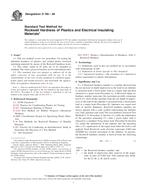Potřebujeme váš souhlas k využití jednotlivých dat, aby se vám mimo jiné mohly ukazovat informace týkající se vašich zájmů. Souhlas udělíte kliknutím na tlačítko „OK“.
ASTM D785-08
Standard Test Method for Rockwell Hardness of Plastics and Electrical Insulating Materials
Automaticky přeložený název:
Standardní zkušební metoda pro Rockwell Tvrdost plastů a elektrických izolačních materiálů
NORMA vydána dne 1.3.2008
Informace o normě:
Označení normy: ASTM D785-08
Poznámka: NEPLATNÁ
Datum vydání normy: 1.3.2008
Kód zboží: NS-39186
Počet stran: 6
Přibližná hmotnost: 18 g (0.04 liber)
Země: Americká technická norma
Kategorie: Technické normy ASTM
Anotace textu normy ASTM D785-08 :
Keywords:
electrical insulating materials, indentation hardness, plastic molding, plastic sheets, Rockwell alpha hardness, Rockwell hardness, Rockwell hardness number, Electrical insulating plastics, Hardness (indentation)--plastics, Rockwell hardness, ICS Number Code 29.035.20 (Plastic and rubber insulating materials)
Doplňující informace
| Significance and Use | ||||||||||||||
|
A Rockwell hardness number is a number derived from the net increase in depth impression as the load on an indenter is increased from a fixed minor load to a major load and then returned to a minor load (Procedure A). A Rockwell alpha (α) hardness number represents the maximum possible remaining travel of a short-stroke machine from the net depth of impression, as the load on the indenter is increased from a fixed minor load to a major load (Procedure B). Indenters are round steel balls of specific diameters. Rockwell hardness numbers are always quoted with a scale symbol representing the indenter size, load, and dial scale used. This test method is based on Test Methods E 18. Procedure A (Section 11) yields the indentation of the specimen remaining 15 s after a given major load is released to a standard 10-kg minor load. Procedure B (Section 12) yields the indentation of the indenter into the specimen after a 15-s application of the major load while the load is still applied. Each Rockwell scale division represents 0.002-mm [0.00008-in.] vertical movement of the indenter. In practice, the Rockwell hardness number is derived from the following relationship:
A Rockwell hardness number is directly related to the indentation hardness of a plastic material, with the higher the reading the harder the material. An α hardness number is equal to 150 minus the instrument reading. Due to a short overlap of Rockwell hardness scales by Procedure A, two different dial readings on different scales may be obtained on the same material, both of which may be technically correct. For certain types of materials having creep and recovery, the time factors involved in applications of major and minor loads have a considerable effect on the results of the measurements. The results obtained by this test method are not generally considered a measure of the abrasion or wear resistance of the plastic materials in question. Indentation hardness is used as an indication of cure of some thermosetting materials at room temperature. Generally, an uncured specimen has a hardness reading below normal. Each Rockwell hardness scale in Table 1 is an extension of the proceeding less severe scale, and while there is some overlap between adjacent scales, a correlation table is not desirable. Readings on one material may be satisfactory for such a table, but there is no guarantee that other plastic materials will give corresponding readings because of differences in elasticity, creep, and shear characteristics. Before proceeding with this test method, reference should be made to the specification of the material being tested. Any test specimen preparation, conditioning, dimensions, and/or testing parameters covered in the materials specification shall take precedence over those mentioned in this test method. If there are no material specifications, then the default conditions apply. |
||||||||||||||
| 1. Scope | ||||||||||||||
|
1.1 This test method covers two procedures for testing the indention hardness of plastics and related plastic electrical insulating materials by means of the Rockwell hardness tester. 1.2 The values stated in SI units are to be regarded as standard. The values given in brackets are for information only. 1.3 This standard does not purport to address all of the safety concerns, if any, associated with its use. It is the responsibility of the user of this standard to establish appropriate safety and health practices and determine the applicability of regulatory limitations prior to use. Note 1—This test method and ISO 2039-2 are equivalent. Procedure A of this test method is equivalent to the test method in the main body of ISO 2039-2. Procedure B of this test method is equivalent to the test method in the integral annex part of ISO 2039-2. |
||||||||||||||
| 2. Referenced Documents | ||||||||||||||
|
||||||||||||||
Odebírejte informace o nově vydaných normách ZDARMA:
Chcete pravidelně odebírat informace o nově vycházejících normách z celého světa a to zcela zdarma?
Přihlašte se k odběru. Vše je velice jednoduché a absolutně ZDARMA.
Na výběr máte vydavatele z celého světa.




 Cookies
Cookies
